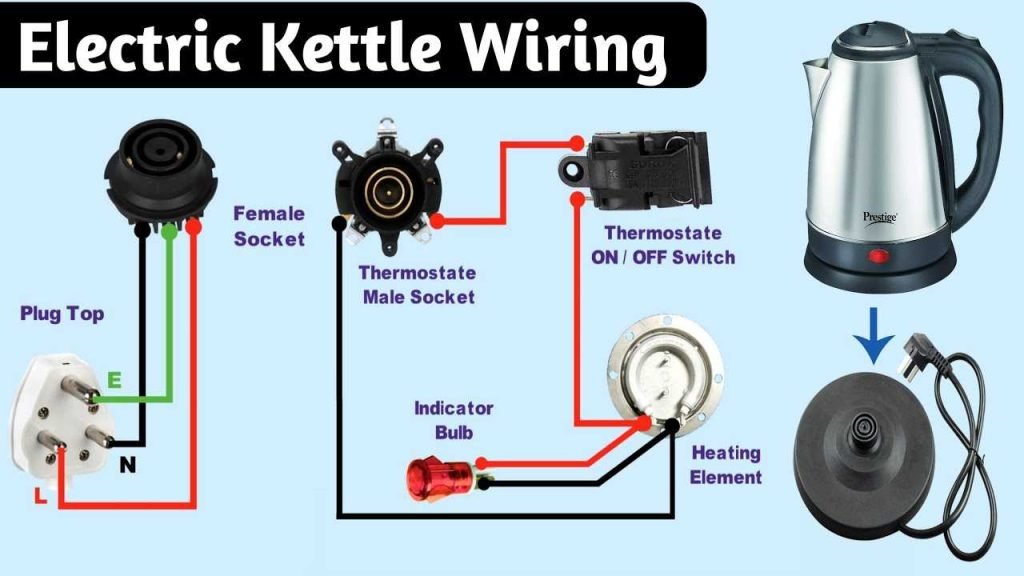To fix an electric kettle quickly, first unplug it and check the power cord and socket for any damage or loose connections. If there’s no issue there, examine the heating element or thermostat for faults, and consider replacing faulty parts or resetting the switch. For most common problems, cleaning limescale buildup or resetting the device usually does the trick.
If your electric kettle isn’t boiling, making strange noises, or not turning on at all, don’t panic. These issues are often caused by simple problems like mineral deposits, a blown fuse, or a faulty switch. Troubleshooting these components can save you money and extend your kettle’s lifespan. Think of your kettle as a small appliance with a few key parts, and addressing these areas can get it back to working smoothly. This guide walks you through easy steps to identify and fix typical electric kettle problems without needing a professional.
How to Fix an Electric Kettle: A Complete Guide
Understanding Common Electric Kettle Problems
Before attempting to fix your electric kettle, it’s important to recognize typical issues. These problems can range from the kettle not turning on to leaks or strange noises. Knowing the symptoms helps you identify the root cause quickly.
Some common problems include the kettle not heating, electrical short circuits, or the device turning off unexpectedly. Recognizing these issues early can prevent further damage and ensure safety during repairs.
Safety Precautions Before Starting Repairs
Always unplug your kettle before inspecting or repairing it. Wait for it to cool down completely to avoid burns. Use insulated tools if possible to prevent electrical shocks. If unsure about handling electrical components, seek professional help.
Ensure the workspace is dry and free of moisture. Wearing safety gloves can also add protection when dealing with internal parts or potential sharp edges. Remember, safety always comes first when repairing electrical appliances.
Tools and Materials Needed
To fix your electric kettle, gather some essential tools. These include a multimeter for testing electrical continuity, screwdrivers (both Phillips and flat-head), replacement parts if necessary, and possibly a soldering iron for wiring repairs. You might also need cleaning supplies like vinegar or lemon juice for descaling.
Having a repair manual specific to your kettle model can make the process easier. Keep all tools within reach and work on a clean, stable surface to prevent accidents.
Diagnosing the Issue
Step-by-Step Troubleshooting
- Check the Power Source: Ensure the outlet is working by plugging in another device.
- Inspect the Power Cord: Look for cuts, frays, or damage. Replace if necessary.
- Test the Power Switch: Use a multimeter to check if the switch is functioning properly.
- Examine the Heating Element: It could be broken or burnt out, preventing boiling.
- Look for Visible Damage: Cracks or burnt marks on the kettle body indicate the need for repairs.
How to Fix Common Electrical Issues
Replacing a Blown Fuse or Faulty Switch
If your kettle has a blown fuse, locate it (usually near the power cord connection). Use a multimeter to check if the fuse is blown. Replace it with one of the same amperage for safety and compatibility.
For a faulty power switch, remove the switch cover, test with a multimeter, and replace if it doesn’t show continuity when pressed. Always handle internal components carefully to avoid damaging other parts.
Repairing or Replacing the Heating Element
The heating element heats the water. If it’s broken or burnt out, the kettle won’t heat water. To replace it, disconnect the power, open the casing, and carefully remove the old element using screwdrivers.
Insert the new element, reconnect wires securely, and test for proper functioning before reassembling. Descaling the element regularly can prevent premature failure caused by mineral build-up.
Cleaning and Maintenance Tips
Regular cleaning helps your kettle stay in good working condition. Use a mixture of vinegar and water to descale mineral deposits. Fill the kettle with equal parts vinegar and water, boil, then rinse thoroughly.
Wipe exterior surfaces with a damp cloth to remove dust and grime. Check and clean the lid and spout to ensure proper water flow. Proper maintenance minimizes repairs and extends the lifespan of your appliance.
When to Seek Professional Repair Services
If repairs seem complex or involve electrical components you’re unfamiliar with, consider hiring a qualified technician. Faulty wiring or internal circuit board issues require expertise for safe handling.
Attempting to fix these parts yourself can risk electric shocks or further damage to the kettle. Use professional repair services to ensure your kettle is safe and functions correctly after repairs.
Replacing Internal Components
How to Replace the Thermostat
The thermostat controls the kettle’s temperature. If it’s faulty, the kettle may not turn off after boiling or not heat at all. To replace it, disconnect the power, locate the thermostat, usually mounted near the heating element, and disconnect its wires.
Install the new thermostat, reconnect wires securely, and test the kettle before reassembling. Ensure the new thermostat matches your model specifications for safety.
Checking and Replacing Internal Wiring
Over time, internal wiring can become brittle or damaged. Carefully inspect wires for cracks or burns. Use a multimeter to check for continuity. Replace damaged wiring with identical gauge wires to maintain safety standards.
Rewire connections properly, ensuring all terminals are tight. Proper wiring ensures the kettle operates efficiently and reduces the risk of electrical faults.
Testing the Repaired Kettle
After completing repairs, plug in the kettle and perform a test run. Observe if the device powers on and heats water properly. Check for any unusual sounds or leaks.
Monitor how long it takes to boil water and ensure the safety features like automatic shut-off work correctly. If everything functions well, your repair was a success.
Preventive Maintenance for Longevity
Descale your kettle regularly to prevent mineral buildup. Use distilled water if possible, especially in areas with hard water. Keep the base and cord clean and free from damage.
Inspect the power cord and plug periodically for signs of wear. Proper maintenance minimizes the need for future repairs and extends your kettle’s functional life.
Related Topics to Explore
- How to replace a kettle’s power cord safely
- Best practices for descaling electric kettles
- Signs your kettle needs replacing rather than repairing
Learning how to fix an electric kettle involves understanding its parts, diagnosing issues, and carefully replacing faulty components. Always prioritize safety and seek professional help if you’re unsure about handling electrical repairs. Proper maintenance can help your kettle last longer and function optimally for years to come.
How to Repair Electric Kettle // with in 20 Sec
Frequently Asked Questions
What should I do if my electric kettle doesn’t turn on?
If your electric kettle doesn’t turn on, check if it is properly plugged into the power outlet. Ensure that the outlet works by testing it with another device. Examine the power cord and plug for any visible damage. If everything seems fine but the kettle still won’t turn on, reset the circuit breaker or try plugging it into a different outlet. Sometimes, the internal switch may have failed, requiring professional repair or replacement.
How can I fix a kettle that stops boiling water early?
If your kettle stops boiling before reaching the desired temperature, mineral buildup inside the heating element could be the cause. Descale your kettle regularly using a mixture of vinegar and water or a commercial descaling solution. Turn off and unplug the kettle, then fill it with descaling solution and let it sit for an hour before boiling and rinsing thoroughly. This clean helps restore proper heating efficiency and ensures consistent boiling performance.
What steps should I take if my kettle’s base isn’t heating properly?
If the base is not heating, inspect the contact points between the kettle and the base. Clean any debris, dust, or mineral deposits from the contacts and ensure the kettle is seated correctly on the base. Check if the power connection at the base is secure. If cleaning doesn’t help, test the base with a different kettle or consider replacing the base if it’s faulty. Faulty wiring inside the base can also be the issue, which requires professional repair.
How can I troubleshoot if my kettle’s safety features keep turning it off?
Electric kettles have safety features like boil-dry protection and automatic shut-off. If these features activate prematurely, check for a buildup of limescale inside the kettle and descale if necessary. Ensure the lid is securely closed, as most kettles won’t operate with an open lid for safety reasons. Also, verify that the kettle is placed on a flat, stable surface. If the safety features continue to trigger despite these measures, consult a technician for a detailed inspection or consider replacing the kettle.
Final Thoughts
Pour résoudre un problème avec votre bouilloire électrique, commencez par vérifier la fiche électrique et le câble. Assurez-vous que la bouilloire est bien branchée et que la prise fonctionne. Si l’appareil ne s’allume toujours pas, examinez le thermostat ou le fusible.
Si la bouilloire ne chauffe pas, il peut s’agir d’un problème avec l’élément chauffant ou le bouton marche/arrêt. Testez ces composants ou faites appel à un professionnel si nécessaire.
En conclusion, pour fix an electric kettle, vérifiez les éléments électriques, le thermostat et le fusible. Ces étapes simples vous aideront à résoudre rapidement le problème.
As an Amazon Associate, We earn from qualifying purchases. When you purchase a product through Amazon links on kitchenadvising.com, we may earn a small commission at no extra cost to you. This helps support the site and keep our content free.


